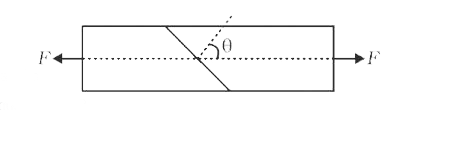A bar is subjected to axial forces as shown. is the modulus of elasticity of the bar is E and A is it cross-section area. Its elongation will be

FlAE
2FlAE
3FlAE
4FlAE
Step by step video & image solution for A bar is subjected to axial forces as shown. is the modulus of elasticity of the bar is E and A is it cross-section area. Its elongation will be by Physics experts to help you in doubts & scoring excellent marks in Class 12 exams.
Updated on:21/07/2023Topper's Solved these Questions
- MECHANICAL PROPERTIES OF SOLIDSBOOK - AAKASH INSTITUTE ENGLISHCHAPTER - MECHANICAL PROPERTIES OF SOLIDSEXERCISE - Assignment(Section-C)
29 Videos
- MECHANICAL PROPERTIES OF SOLIDSBOOK - AAKASH INSTITUTE ENGLISHCHAPTER - MECHANICAL PROPERTIES OF SOLIDSEXERCISE - Assignment(Section-D)
14 Videos
- MECHANICAL PROPERTIES OF SOLIDSBOOK - AAKASH INSTITUTE ENGLISHCHAPTER - MECHANICAL PROPERTIES OF SOLIDSEXERCISE - Assignment(Section-A)
54 Videos
- MECHANICAL PROPERTIES OF FLUIDSBOOK - AAKASH INSTITUTE ENGLISHCHAPTER - MECHANICAL PROPERTIES OF FLUIDSEXERCISE - SECTION - J
9 Videos
- Mock test 03BOOK - AAKASH INSTITUTE ENGLISHCHAPTER - Mock test 03EXERCISE - EXAMPLE
44 Videos
Similar Questions
A bar of mass m and length l is hanging from point A as shown in the figure . If the Young's modulus of elasticity of the bar is Y and area of cross - section of the wire is A, then the increase in its length due to its own weight will be

View SolutionA rod 100 cm long and of 2cm×2cm cross-section is subjected to a pull of 1000 kg force. If the modulus of elasticity of the materials is 2.0×106kg/cm2, determine the elongation of the rod.
View SolutionA bar of mass m and length l is hanging from point A as shown in figure.Find the increase in its length due to its own weight. The young,s modulus of elasicity of the wire is Y and area of cross-section of the wire is A.

View SolutionA bar of mass m and length l is hanging from point A as shown in figure.Find the increase in its length due to its own weight. The young's modulus of elasicity of the wire is Y and area of cross-section of the wire is A.

View SolutionA uniformly tapering circular bar has its diameter ranging from (D-a) to (D+a) along its length L. The bar is subjected to an axial force P and young's modulus is Y. The percentage error in the calculation of elongation of bar if mean diameter is used in calculation instead of actual diameter.
View SolutionCalculate the compressional force required to prevent the metallic rod of length l cm and cross sectional area Acm2 when heated through t∘C from expanding lengthwise. Young's modulus of elasticity of the metal is E and mean coefficient of linear expansion is α per degree celsius.
View SolutionA metallic rod l cm long, A square cm in cross-section is heated through t∘C. If Young’s modulus of elasticity of the metal is E and the mean coefficient of linear expansion is α per degree celsius, then the compressional force required to prevent the rod from expanding along its length is
View SolutionCalculate the compressional force required to prevent the metallic rod length lcm and cross-sectional area Acm2 when heated through t∘C, from expanding along length wise. The Young's modulus of elasticity of the metal is E and mean coefficient of linear expansion is α per degree Celsius
View SolutionA bar of cross-section A is subjected to equal and opposite tensile forces at its ends. Consider a plane section of the bar whose normal makes an angle θ with the axis of the bar .
(i) What is the tensile stress on this plane?
(ii) What is the shearing stress on this plane?
(iii) For what value of θ is the tensile stress maximum
(iv) For what value of θ is the shearing stress maximum?

View SolutionConsidering a wire of non-uniform cross-section as shown.If the area of cross-section at A is double of the area of cross-section at point B.Ratio of heat energy dissipated in a unit volume per unit time at points A and B is
_PHY_E05_279_Q01.png)
View Solution
